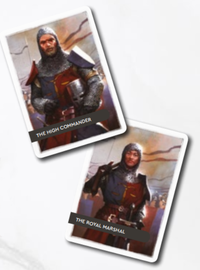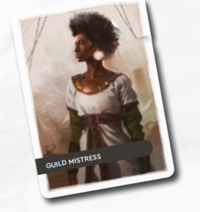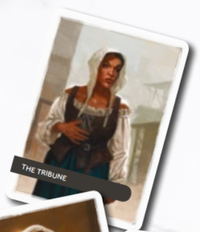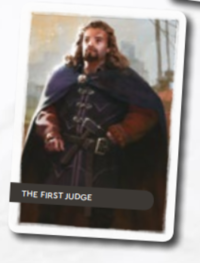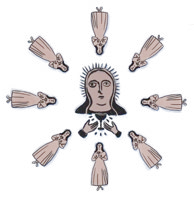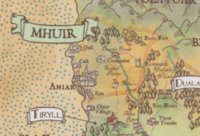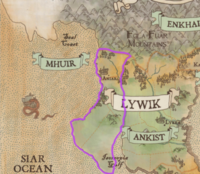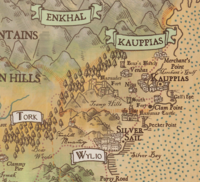Part 165: Additional info on the Kingdom of Ankist
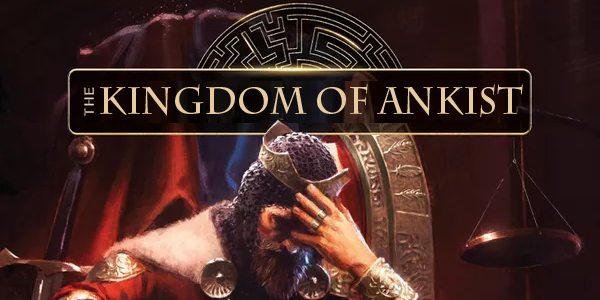
Ankist is one of the largest states in Lywik, but it’s not the only one. Ankist itself is the result of the union of many formerly independent kingdoms, conquered in wars or united by diplomacy, that were incorporated over the centuries as Duchies or Marks. The north and the south of Ankist have uncertain borders: the unclaimed borderlands are full of raiders, cutthroats, and dangerous nomadic tribes.
The structure of the kingdom is feudal. The Duchies and the Marks are managed by their ruling Houses, represented by the players; these families are all loyal to the king of Ankist, but also have counts and barons that are loyal to them. The Houses are responsible for rallying the army, gathering taxes, and generally administering their territory in the name of the King. The King is personally assisted by the Chamberlain, who will deal with the Council about several general matters. The Council can also rely on the Royal Treasurer, who is charged with monitoring the finances and dealing with the economy of the kingdom.
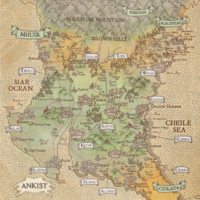
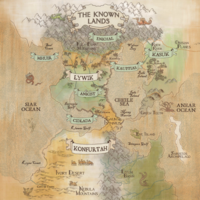
The Army posted:
Recruited by the Dukes and Marquises but under the direct orders of the Council, the army keeps peace and order in the kingdom. The Council’s strategic orders are executed by two generals: the High Commander, who reports directly to the Council about external threats and commands the army during wars, and the Royal Marshal, who leads the King’s Guard and intervenes in case of riots or other internal troubles. Only a minority of the soldiers are regulars: most of them are conscripts, men and women called to serve in times of need that go back to their homes in times of peace.
The Merchants posted:
They are entrepreneurs who run commercial activities and finance trading expeditions. They generally have a large income or fortune that they can rely on. To pursue their commercial interests, the merchants of Ankist unite themselves into local guilds. They don’t usually behave as a united faction, because the various guilds may have diverging interests, but they periodically elect a Guild Master or Mistress, who is considered neutral by all the guilds and speaks to the Council for all of them.
The Common People posted:
With their numbers and resiliency, they are the backbone of the kingdom. They mostly have humble jobs like farming, woodcutting, tailoring, or mining. They do not own any significant wealth and the fruits of their work serve them just to get by. Their interests are defended by the Tribune, an elected figure with a mandate of ten years who reports the problems of the common people to the Council.
Justice posted:
With the conviction that each wrong must be followed by an equal and opposite reaction to restore balance, justice in the kingdom of Ankist is commonly based on the law of retaliation: the more serious the felony, the more harsh the punishment. The more common crimes are dealt with by local judges, although the duke, marquis, or even the king may be consulted to ask for a pardon. On the other hand, the most ambiguous cases are brought to the attention of the First Judge, an expert and wise man of law at the head of the Justice Court of Lybra, who studies these matters and submits their advice to the Council.
The Cult of the Mother posted:
The Cult of the Mother is the only religion in the kingdom of Ankist and in most of the other known lands.The Mother is considered the only true goddess, and she is worshipped as a benevolent figure together with her eight Saint Daughters. However, especially in remote places, paganism is sometimes still present, but the Cult treats it as superstition, claiming that the pagan gods are likely misinterpretations of the Saint Daughters.
Dogma
The religion of the Cult is based on the fact that all is created and regenerated by the Mother. When you die, you go back to the Mother’s womb where you will be regenerated before being born again. Birth and death are equally important: birth can’t be prevented in any way and corpses must be buried in order to go back to the Mother. The Cult claims that the Mother once walked in this world in human form to elevate humanity above the beasts, but she was not human.
This dogmatic truth has been questioned by several heretical theories in the past. A famous heresy theorized the existence of a “Ninth Daughter,” and claimed that the Mother was not an immortal goddess, but just the empress of an ancient civilization, part of a matrilineal dynasty where the ninth daughter would inherit command. Another heresy asserts that the Saint Daughters are as divine as the Mother: they would actually be her sisters, and the Mother herself would be the aforementioned ninth. Yet another one says that the Saint Daughters were actually the ancient pagan gods who were defeated by the Mother and submitted to her will. These heresies are all vigorously denied by the Cult.
The Eight Saint Daughters of the Mother
The Cult worships the Mother and her Saint Daughters as a unity, but commoners may ask the favor of a specific Daughter according to what they need. The Saint Daughters have a dual nature: They each represent a virtue they gifted to the world and the avoidance of a vice that could be fostered by an excess of that same virtue. In this sense, the Saint Daughters represent harmony and balance. Those who seek courage without recklessness will pray to Tilde. Those who seek strength and vigor without violence will pray to Orsal. Those who pray to Aegna will have wisdom and avoid folly. Those who seek creativity, arts, and games will pray to Lyria, who will tell them when playfulness must stop. Aire is the patron of love, but she is mindful to avoid jealousy. Those who need their business to thrive will ask Raela to intercede for them and they will be granted wealth as long as they are generous with it. Caerthas brings justice, but always with mercy. Those who seek rest or think they deserve to feast after a great effort will pray to Myhir, without ending in laziness.
Classic, non-Munchian representation of the Mother and her eight daughters.
Structure of the Cult
The Cult of the Mother only allows women to join its ranks. The priestesses of the Cult informally call each other “Sisters” and live in monasteries. Priestesses can indulge in romantic relationships and have children, but they usually do not marry, even if it is not formally forbidden. They can raise their daughters at the monasteries until they reach puberty, then the girls can chose to become priestesses themselves or to leave. If a priestess gives birth to a son, he will be have to be raised by his father, outside of the monastery.
The monasteries are of different sizes and shapes, but all of them, from the smallest village monastery made of only two rooms to the biggest ones which can host up to hundreds of priestesses, have a public space, where all the believers gather and assist in the rites, and a private space, where the priestesses live and perform special rituals. Only priestesses can enter this space, but while lay women may occasionally be welcomed as guests, access is never allowed to men. The biggest monasteries are lead by an elected figure called the High Priestess.
The Kingdom of Mhuir posted:
Ankist shares a border with Mhuir to the northwest. The two kingdoms used to be almost comparable in size a few decades back, but Mhuir is now much smaller after they lost a war against Ankist in the year 143. Still, it is culturally and technologically more advanced.
The lands of Solad, Blodyn and Tyrill were once part of Mhuir. In the year 143, nobles of Tyrill rebelled against the Mhuirian Kingdom after the crown tried to force them to share and redistribute their riches with the rest of the Kingdom; Ankist was quick to support the rebels and after the bloody war of 143, Tyrill was annexed to Ankist and those nobles were granted the title of Marquis. The land ruled by the Dukes of Blodyn and the Dukes of Solad was also annexed at the end of the war, after Mhuir was defeated, as part of the peace accords.
The Southern Continent posted:
Besides the coastal city-states, the southern continent is barely explored. The inland is apparently wholly occupied by a vast desert called the Ivory Desert, where no one can live, while a tall mountain range called the Nebula Mountains cross it from north to south, splitting it into two halves.
The Republic of Kauppias posted:
The Republic of Kauppias, despite ruling over the cold and rocky territories located to the northeast of the Kingdom of Ankist, has commercial abilities beyond imagination that more than compensate for the harshness of their homeland. Their leader, the Doge, is elected every five years among the most talented merchants, and despite having only limited powers, they are the head of their army of mercenaries and, most importantly, they can veto the decisions of the Bank of Cards, one of the most influential banks in the whole world.
History of the World posted:
At the present time, Ankist is one of the strongest and largest kingdoms in the world, and has enjoyed several decades of peace. But less than two centuries ago it was divided into many small kingdoms and raider tribes. Little is known about what happened before this age of fragmentation, but what we know for sure is that the lands of the current Kingdom of Ankist, as well as most of the other known lands, were ruled by several lost civilizations throughout the ages. The monumental vestiges they left behind are present in most of the cities of the kingdom.
The Salaan Union (Around 800 years Ago)
All that remains of this great civilization are a few vestiges on the coasts of both the Siar Ocean and the Cheile Sea, such as gigantic lighthouses in ruins or shipyards readapted throughout the centuries and still in use in some cities of the kingdom. Some say that in ancient times their rule spanned over the whole world.
The Sabbiyan League (Around 1100 years Ago)
Older ruins are present across the south of Ankist. Many market squares in the southern cities are built around these structures, and a few obelisks made from sculpted sandstone survived the test of time. The bas-relief scenes represented on these obelisks mainly depict scenes of trade, suggesting that commerce was the main strength of this civilization.
The First King (Around 1400 yeArs Ago)
Historians agree that all of the most ancient and timeworn monasteries of our kingdom (and beyond) were built by Ommad, the legendary First King, a historical yet almost mythical figure. His rule allegedly spanned over the whole world, and even though it ended hundreds of years before our kingdom was even born, our royal family claims to have a direct lineage from him. At the present time, he’s praised more for bringing the Cult of the Mother to our continent and converting the northern pagan tribes than for his considerable military successes. He was so illustrious, that every state claims to be his birthplace.
Mythical History
Some historians suspect there was another forgotten Empire that might have been the cradle of civilization. This belief comes from the many spurious copies of a legendary artifact that has been lost for centuries, called the Golden Map. We’ve been seeking this item for decades to no avail
